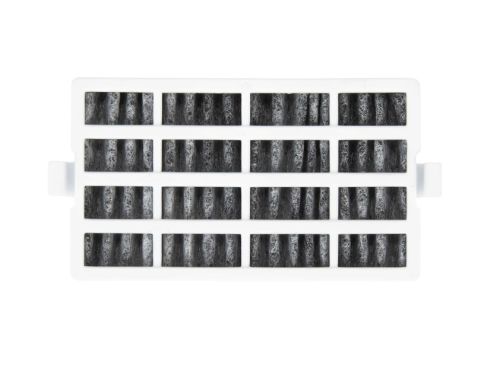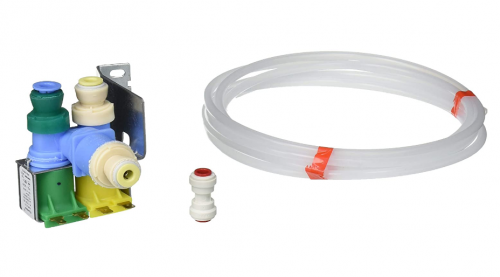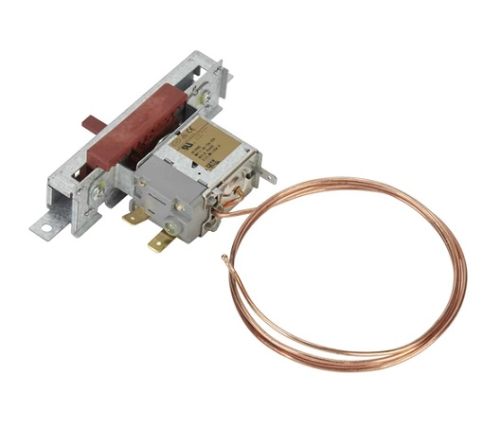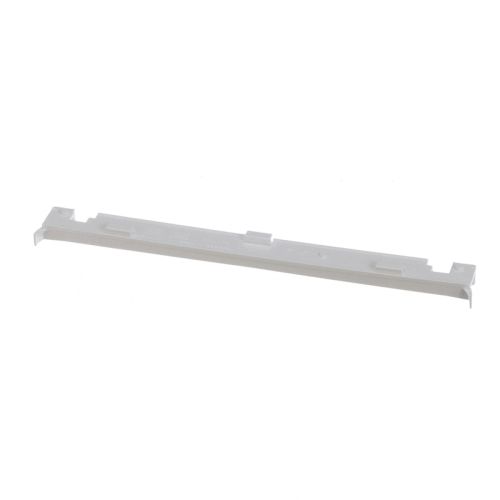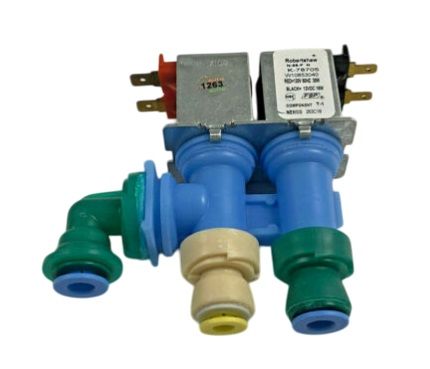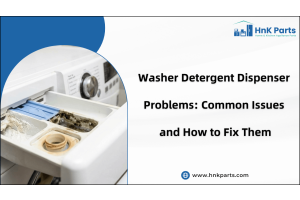
How to Replace Fridge Water Filter: Step-by-Step Guidance
A water filter in a fridge is essential for ensuring clean and safe drinking water. A refrigerator water filter can effectively remove the unwanted elements, resulting in fresher and better-tasting water.
A water filter helps eliminate potential health risks associated with consuming contaminated water. Harmful bacteria, parasites, heavy metals, and other pollutants can be present in untreated water, posing health hazards if ingested. The filter's ability to remove these impurities provides an added layer of protection, making the water safe for consumption. Using a water filter in the fridge is not only convenient but also economical. Instead of relying on bottled water, which generates plastic waste and can be costly in the long run, a water filter offers a more sustainable and cost-effective solution for obtaining clean drinking water at home.
Here we will see the complete details about the water filter and a step-by-step guide to changing the water filter in the fridge.
What Is a Water Filter in Your Refrigerator?
A refrigerator water filter is a device designed to purify and improve the quality of the water that comes through your fridge's water dispenser or ice maker. It is a small, cartridge-like component typically located inside the fridge, near the top or bottom.
It uses filtration technology, often with activated carbon, to remove impurities like chlorine, sediment, and other contaminants present in tap water. The water filter ensures that the water you drink or use for ice is clean, safe, and has a better taste. Regularly replacing the filter is important to maintain its effectiveness and provide you with fresh, filtered water at all times.
How Does a Water Filter Work in Fridge?
A water filter in a fridge works through a process of filtration, where it uses various technologies to remove impurities and contaminants from the water before it is dispensed or used for making ice. The typical filtration process involves the following steps:
- Physical Filtration: The water first passes through a physical filter, which is often made of activated carbon. This filter has a porous structure that can trap larger particles like sediment and debris, effectively removing them from the water.
- Chemical Filtration: As the water flows through the activated carbon, it undergoes chemical filtration. The carbon has an adsorption property, meaning it attracts and binds certain impurities like chlorine, volatile organic compounds (VOCs), and some heavy metals.
- Mechanical Filtration: Some water filters in fridges also include a mechanical filtration stage, where the water passes through a fine mesh that further removes smaller particles and contaminants.
The combination of physical, chemical, and mechanical filtration ensures that a wide range of impurities is effectively removed from the water, resulting in cleaner and safer drinking water.
As the water filter continues to be used, it gradually becomes less effective at filtering impurities and can even become a breeding ground for bacteria. Therefore, it is essential to replace the refrigerator water filter at regular intervals, usually every six months or as specified by the refrigerator manufacturer, to maintain its efficiency and ensure the water remains clean and safe for consumption. Regular replacement helps to avoid clogging and maintains the filter's ability to provide fresh, filtered water that is free from unwanted contaminants.
How to Tell If Fridge Water Filter Is Bad?
A fridge water filter needs to be replaced when it becomes ineffective at removing impurities from the water. Here are some common signs that can indicate if your fridge water filter is bad and needs replacement:
- Change Indicator Light: Many modern refrigerators come with a built-in filter change indicator light. This light will typically illuminate or change color when it's time to replace the water filter. Refer to your refrigerator's user manual to understand how the indicator light works for your specific model.
- Decreased Water Flow: A clogged or old fridge water filter may cause a decrease in water flow from the dispenser or ice maker. If you notice that the water flow is slower than usual, it could be an indication that the filter needs replacement.
- Bad Taste or Odor: As a water filter becomes less effective, you might notice a change in the taste or odor of the water. If the filtered water starts to taste unpleasant or has an odd smell, it's likely time to replace the filter.
- Cloudy or Discolored Water: An expired water filter might fail to remove certain impurities, leading to cloudy or discolored water. If you see that the filtered water appears turbid or has an unusual color, it's a sign that the filter is no longer working optimally.
- Visible Sediment or Particles: In some cases, you may observe visible sediment or particles in the filtered water. This indicates that the filter is not effectively removing all impurities, and it needs replacement.
- Regular Maintenance Schedule: If you cannot remember the last time you replaced the water filter and it's been more than six months, it's a good idea to replace it as a preventive measure.
To maintain the quality of your water and ensure safe consumption, it's important to follow the manufacturer's recommended replacement schedule for your fridge water filter. Regularly replacing the filter will keep your water clean, fresh, and free from contaminants, providing you with a continuous supply of high-quality drinking water.
How Often to Change Water Filter in Fridge?
The frequency of changing the water filter in your fridge depends on the type of filter and the model of your refrigerator. Generally, most manufacturers recommend replacing the refrigerator water filter every six months. However, there are a few factors that can affect how often you need to change the filter:
- Water usage: If you use a large amount of water from your fridge's dispenser and ice maker, the filter will get used up more quickly, and you may need to replace it more often.
- Water quality: If your water supply contains high levels of impurities, the filter will have to work harder and may need more frequent replacement.
- Manufacturer's recommendations: Always follow the specific guidelines provided in your refrigerator's user manual or by the manufacturer. They will typically have the most accurate information for your particular model.
To ensure the water and ice from your fridge are of the highest quality, it's essential to replace the water filter regularly. Some refrigerators may have an indicator light that reminds you when it's time to change the filter. If there is no indicator, you can set a reminder on your own or mark your calendar to replace the filter every six months or as recommended by the manufacturer.
Know more about the Key parts and accessories of a refrigerator.
Necessary Tools and Replacements Water Filter for Fridge
To change the water filter for your fridge, you'll need a few necessary tools and supplies. The specific tools required may vary depending on the refrigerator model, but generally, you will need the following:
- Replacement Water Filter: Make sure you have the correct replacement water filter that matches your fridge's make and model. Refer to the refrigerator's user manual or check the model number to find the appropriate filter.
- Owner's Manual: Keep the owner's manual of your refrigerator handy. It often includes instructions on how to change the water filter specific to your model.
- Safety Gloves: It's a good idea to wear safety gloves while handling the water filter to avoid contact with any contaminants.
- Safety Glasses: Wearing safety glasses can protect your eyes in case of any accidental splashing.
- Clean Cloth/Towel: Have a clean cloth or towel nearby to wipe away any spills or drips that might occur during the process.
- Bucket or Container: Place a bucket or container underneath the filter housing to catch any water that may spill out when removing the old filter.
- Adjustable Wrench (if required): Some refrigerators have filter housings that need an adjustable wrench to loosen and remove.
- Filter Bypass Plug (if needed): In some cases, if you do not have a new water filter ready to install, you might need a filter bypass plug to ensure the fridge's water and ice dispensers continue to work without a filter.
Always remember to turn off the water supply to the refrigerator before attempting to change the water filter. Follow the manufacturer's instructions from the owner's manual for your specific refrigerator model to ensure you are doing the replacement correctly and safely. If you are unsure about where to buy the replacement parts, buy them from HnKParts. We offer the best quality and genuine OEM replacement parts for all your kitchen and home appliances including Refrigerator parts.
How to Replace Water Filter in Fridge: Step-by-Step Guide
Replacing the water filter in your fridge is generally a straightforward process, but it's essential to follow the specific instructions for your refrigerator model. Here's a general step-by-step guide to help you replace the water filter:
Step 1: Purchase the Correct Replacement Filter
Ensure you have the right replacement water filter that matches your fridge's make and model. Check the owner's manual or the refrigerator's labeling for the correct filter part number.
Step 2: Turn off the Water Supply
Locate the water shut-off valve for the refrigerator's water line, which is usually located behind or beneath the fridge. Turn off the water supply to prevent water from flowing when you remove the filter.
Step 3: Find the Water Filter Housing
The water filter housing is typically located inside the refrigerator compartment. It may be in the top right or left corner, the bottom grille, or the rear of the compartment.
Step 4: Remove the Old Water Filter
Depending on your refrigerator model, the process to remove the old filter may vary:
- Twist and Pull: Some filters can be removed by turning them in a counterclockwise direction and then pulling them straight out.
- Push Button: For certain models, there might be a button or latch near the filter housing that releases the filter when pressed.
- Twist and Drop: In some fridges, you'll need to twist the filter counterclockwise and then pull it down to remove it. Make sure to keep a bucket or container underneath the filter housing to catch any water that may spill out during removal.
Step 5: Prepare the New Water Filter
Remove the new water filter from its packaging. If there are any protective covers or seals, make sure to remove them before installing the filter.
Step 6: Install the New Water Filter
Follow the reverse process of how you removed the old filter to install the new one:
- Insert the filter into the filter housing.
- Twist it clockwise until it locks into place.
- If your filter has a cap or cover, install it securely.
Step 7: Flush the Water Filter
Some filters need to be flushed before use to remove any carbon residue or impurities. Follow the manufacturer's instructions on how to flush the new filter.
Step 8: Turn on the Water Supply
Once the new filter is installed and flushed (if required), turn the water supply back on by reopening the shut-off valve.
Step 9: Reset the Filter Indicator (if applicable)
If your refrigerator has a filter replacement indicator light or display, reset it according to the instructions provided by the manufacturer in the user guide. This step helps you keep track of when the next replacement is due.
Step 10: Check for Leaks
After replacing the water filter, check for any leaks around the filter housing and connections. Tighten any fittings if necessary.
Always refer to your refrigerator's owner's manual for specific instructions and any model-specific nuances during the replacement process. If you encounter any difficulties or uncertainties, don't hesitate to contact the refrigerator manufacturer or seek assistance from a professional.
Read more to find out How To Install Refrigerator Water Line.
Flushing and Testing the New Water Filter in Fridge
Flushing and testing the new water filter in your fridge is a crucial step to ensure the filter works effectively and delivers clean and safe drinking water. The process involves removing any carbon residue or impurities that may be present in the filter or water lines. Here's a brief overview of the steps:
- Flushing the Filter: After installing the new water filter, run water through the refrigerator's water dispenser for approximately 2-3 minutes. This helps clear out any carbon particles or cloudiness that might be present in the filter.
- Check for Leaks: While flushing, inspect the filter housing and water connections for any leaks. Address any leaks to prevent water wastage and ensure proper installation.
- Discard First Ice Batch: If your fridge has an ice maker, discard the first few batches of ice produced after replacing the filter. This eliminates any potential impurities that might have entered the ice maker during the filter change.
- Taste and Smell Test: After flushing, taste and smell the water. It should be clean and free from any unusual flavors or odors. If you notice any issues, double-check the filter installation or seek assistance from the manufacturer.
- Reset Filter Indicator: If your fridge has a filter replacement indicator, reset it to keep track of the next replacement date accurately.
Properly flushing and testing the new water filter helps maintain the water quality, ensures the filter functions optimally, and provides you with fresh and healthy drinking water and ice from your refrigerator.
Fridge Water Filter Maintenance Tips for the Future
Maintaining a fridge water filter is essential to ensure clean and healthy drinking water and optimal performance of your refrigerator's water dispenser. Here are some brief tips to help you keep your fridge water filter in good condition:
- Regular Replacement: Follow the manufacturer's guidelines and replace the water filter at the recommended intervals. Typically, it's advised to replace the filter every 6 months, but this may vary depending on the model and water quality.
- Filter Reset: After replacing the water filter, reset the filter indicator on your refrigerator. This step is crucial to ensure accurate monitoring of the filter's lifespan.
- Check Water Quality: Monitor the water quality to detect any changes in taste, odor, or clarity. If you notice any issues, it might be time to replace the filter, even if it hasn't reached its recommended lifespan.
- Flush the Filter: When installing a new filter or after long periods of non-use, flush it to remove any air pockets or loose carbon particles.
- Clean External Surfaces: Wipe down the exterior of the filter housing regularly to prevent the buildup of dirt, grime, or bacteria.
- Avoid Hot Water: Avoid using hot water in your refrigerator's water dispenser, as it can reduce the effectiveness and lifespan of the filter.
- Keep the Fridge Clean: Regularly clean the interior of your refrigerator to prevent mold or bacterial growth, which could affect the water quality.
- Check for Leaks: Inspect the water filter and its connections for any signs of leaks or damage. Address any issues promptly to avoid water damage to your fridge or surrounding areas.
- Avoid Air Contaminants: Store food properly to prevent strong odors from permeating the refrigerator and affecting the taste of the filtered water.
By following these simple maintenance tips, you can ensure that your fridge water filter works efficiently, providing you and your family with clean and refreshing drinking water. Always refer to your refrigerator's manual for specific maintenance instructions tailored to your model.
Follow our step-by-step guide to replace your water filter by yourself and we have also mentioned some common tips to maintain your fridge water filter in good condition. While replacing any parts and accessories related to your home and kitchen appliances, look no further than HnKParts. We provide high quality replacement parts and accessories that are genuine OEM.
FAQs:
How long does a fridge water filter last?
The lifespan of a fridge water filter typically varies depending on the specific model and usage, but on average, most filters last around 6 months.
How do I know what type of water filter my refrigerator needs?
To determine the type of water filter your refrigerator needs, check the user manual or look for the model number on your fridge. Then, search for the specific filter compatible with that model online or contact the manufacturer for assistance.
What is the most effective type of water filter?
The most effective type of water filter is a reverse osmosis (RO) filter. It can remove a wide range of contaminants, including bacteria, viruses, heavy metals, chemicals, and other impurities, providing high-quality and purified drinking water.
What type of home water filter do you recommend and why?
I recommend a combination of a carbon block filter and a reverse osmosis (RO) system. The carbon block filter removes chlorine and odors, while the RO system effectively eliminates a wide range of contaminants, providing safe and clean drinking water.
Which type of filter requires the least amount of water to clean?
The type of filter that requires the least amount of water to clean is a backwashable or backwashing filter. Backwashing filters are designed to clean themselves by reversing the flow of water through the filter media, dislodging and flushing out trapped particles and debris.
Does the fridge water filter matter?
Yes, the fridge water filter matters. It helps improve water quality, removes contaminants, and ensures safe drinking water and ice.


